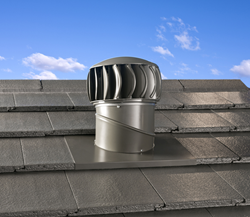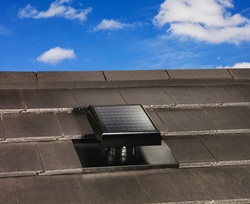The Ultimate Guide to Roof Ventilation

The Australian sun is powerful and well-known for rapidly heating everything in its path. Your roof space is no exception; without ventilation, hot and humid air becomes trapped and creates an uncomfortable home environment. Thankfully, roof ventilation is a cost-effective, simple way to efficiently regulate your home's temperature.
Roof vents are an important part of a healthy home and complete roofing system. Read on to discover why they're important, their benefits, how they work, the different types of roof vents, and how they should be installed.
Why is roof ventilation important?
Roof ventilation helps create a comfortable, healthy, and energy-efficient home. Vents provide many key benefits, such as:
Help prevent condensation and mould-related damage
Condensation and moisture built-up is a destructive force, causing rot and encouraging mould and mildew growth. In turn, air quality suffers, triggering asthma and allergy-related illnesses. Roof ventilation helps to expel humid, moist air that leads to condensation and mould, protecting the integrity of your home and creating a healthier home environment.
Extends the life of your roof
Adequate roof ventilation helps extend the life of your roof, making it a cost-effective way to add value and durability to your roofing system. A well-ventilated roof cavity allows hot and humid air to escape, minimising the risk of condensation, rot, and mould.
Reduces energy costs
A well-ventilated home allows heat to escape your roof space and replaces it with ambient, outdoor air. Inside your home, this reduces the load on your air conditioning, minimising your energy bills and creating an energy-efficient home.
Helps reduce heat
During hot Australian summers, heat builds up in your roof space. Without ventilation, these temperatures can reach troubling extremes of 70°C. Bradford Ventilation solutions remove this heat, replacing it with fresh outdoor air to help reduce heat and humidity for a more comfortable home.
How does roof ventilation work?
Roof ventilation regulates the temperature and humidity of a roof space by allowing ambient, drier air to replace hot air.
Hot air rises, but without adequate ventilation, the heat is unable to escape your roof cavity, creating an uncomfortable home and raising energy bills. With roof ventilation, rising hot air and moisture build-up can escape, while fresh air is brought inside to maintain a comfortable temperature, minimise condensation, and reduce energy costs.
What are the different types of roof vents?
When choosing roof ventilation, there are three main types of roof vents to consider:
Powered ventilators
Powered ventilator solutions are typically mains connected or solar-powered and provide powerful, continuous and effective ventilation to reduce heat and humidity build-up. They’re the most effective form of ventilation; one electricity-driven vent is equivalent to multiple wind-driven vents for the same roof space. Powered ventilators offer variable and fixed-speed options to suit your home's unique climate and needs. Examples include Bradford's AiroMatic and SolarXVENT.
Wind-driven ventilators
Wind-driven ventilators operate without consuming any energy. Typically designed as roof-mounted turbines, wind-driven ventilators offer quick and easy installation and are incredibly economical, even providing effective ventilation in conditions without wind through a stack effect (the natural force from changes in air pressure, density levels and temperature). Examples include Bradford's WindMaster and SupaVent.
Static vents
Static ventilation solutions allow heat and humidity to escape your roof space without needing wind or power. Statics vents best suit your home's wet areas (such as your laundry, kitchen and bathroom). Examples include Bradford's Roof Valve.
How do you choose a roof vent?
When choosing a roof vent, you should consider:
How much ventilation is needed
You may need multiple vents, depending on your roof's size, pitch and shape.
What types of roof vents are available
Familiarising yourself with the types of roof vents available on the Australian market can help you choose the best solution for your climate and needs.
How the roof vent is powered
With multiple power options available - including solar-powered, electric, and wind-driven - considering how you'd like your roof vents powered will help you choose your ideal roof ventilation system.
How many vents do you need on a roof?
To avoid condensation and allow heat to be exhausted effectively, you'll need one natural vent every 90 square metres. When considering how many vents you need and your home's square footage, it's worth remembering that not all ventilation systems are the same. Some systems - such as Bradford's AiroMatic™ - are as effective as up to six natural vents, so less can be installed to achieve the same result. Less vents on your roof also means less perforations when installing the product.
Not sure how many vents you need or what the best solution is for your home? Contact us today to let us know how we can help!
Where should vents be placed on a roof?
Tiled roof
For maximum performance, we recommended installing vents along the 3rd or 4th row of tiles (from the ridge). Higher positions may damage the ridge, while lower positions reduce performance and increase the risk of leakage in heavy rain. It’s also important to ensure vents aren’t installed too close to the ridgeline on the sides of your tiled roof as well.
Metal roof
Vents must be installed to the ridge cap on metal roofs. Any other installation requires a licensed plumber.
Download our installation manual to learn more about installing natural ventilators.
How far apart should roof vents be?
Generally, a roof needs one vent every 90 square metres.
As well as this, you should allow four eave vents per roof vent to allow sufficient air circulation (air exhausted by the vents will be replaced by fresh air outside).
How long do roof vents last?
Roof ventilation is a simple, cost-effective way to reduce heat and humidity build-up in your roof space, thanks to Bradford ventilation systems' long-lasting nature. At Bradford, we care about sustainability and view it as the ability to maintain and develop long-term performance. That's why we continuously test and innovate to design energy-efficient, durable natural and powered ventilation solutions that improve the comfort of your home, reduce energy costs, and offer longevity.
Our wind-driven vents also come with a 15-year warranty for sustained home comfort and long-lasting peace of mind.
What roof vents are available?
Energy-efficient and cost-effective, the Bradford WindMaster is a natural wind-driven ventilator designed to reduce heat and dampness from your home's roof space without using electricity. For long-lasting home comfort, the Windmaster is constructed from high-quality, durable aluminium and comes with a 15-year warranty.
.jpg?h=218&w=250&la=en&hash=06A278EC229550AFC40AE8BDD485A45343D3D99B)
The Bradford SupaVent is a natural wind-driven ventilator specially designed to perform in the lightest of breezes to reduce heat and dampness from your roof space on relatively still summer days. Constructed from a durable UV stabilised polymer with stainless steel ball bearings, the SupaVent is resistant to rust and corrosion, making it ideally suited to Australia's coastal region. For long-lasting home comfort, the SupaVent comes with a 15-year warranty.

With a powerful, automatic fixed speed and low-profile design, the Bradford AiroMatic complements most metal and tiled roofs to produce a high-performance system as effective as up to six natural vents. A smart-powered ventilation system with built-in Air iQ, the AiroMatic offers advanced protection against condensation and a state-of-the-art ability to reduce internal heat loads.
.jpg?h=204&w=250&la=en&hash=B7EA6CED0607655950536A5BCA40818D858BA228)
Harness the power of the sun to exhaust humidity and heat from your roof space. The SolarXVENT is a smaller, solar-powered vent fitted with a highly-efficient 10-watt solar panel to create a comfortable, energy-efficient space when you need it most. With a low-profile design resistant to UV, impact and corrosion, the SolarXVENT is ideally suited to the harsh conditions of Australia's coastal regions and, due to its smaller size, optimal for use in sheds and garages.

